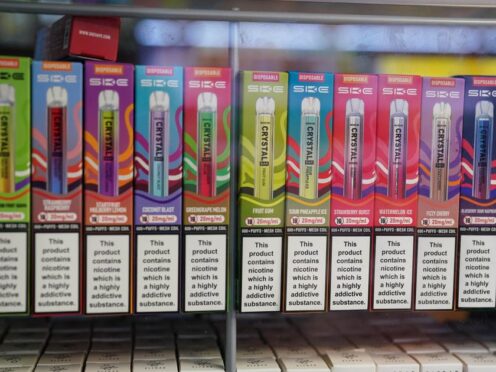
Vaping-addicted children should be given nicotine patches or gum to help them break their addiction, public health officials have said.
A report by Public Health Wales (PHW) – one of the organisations that makes up NHS Wales – has said that vaping should be seen as a “dependency issue” rather than a deliberate act of misconduct, with young people needing support to quit.
The report found that children felt pressure to “fit in and look cool”, with “vape dealers” across social groups.
To help children break their addiction, PHW’s incident response group (IRG) has made a series of recommendations, including that young people with dependency issues be given access to nicotine replacement therapies, such as chewing gum, skin patches, or inhalators.
Other recommendations include restrictions on vape visibility, appeal and availability to young people, such as a ban on colourful packaging.
Chris Emmerson, a public health consultant for PHW, said there is a “clear consensus view” that the rise in youth vaping “must be addressed with urgency” if it is to be tackled quickly and effectively.
He said: “These best practices provide a comprehensive framework for supporting young vapers in Wales.
“By implementing these practices, we can better address the complex needs of children and young people struggling with vaping dependency.
“Nicotine replacement therapies, which are already offered to people aged over 12 who are smoking, is one tool that could help children and young people out of their dependency on vaping in tandem with other support mechanisms.”
The IRG’s report said that access to vapes was “relatively convenient” for children, which are often sourced from older siblings and family members, shops and online stores.
It said: “Vaping was most frequently observed in visible (although sometimes secluded) social settings.
“This environment seemed to contribute to feelings of peer pressure. Participants described a strong desire to fit in and look cool and found it difficult to refuse offers to share devices.”
The IRG’s recommendations are:
– Vapes should be “denormalised” and not permitted in spaces intended for children
– The advertising and display of vapes should be restricted, with only plain, unbranded packaging
– Disposable vapes should be banned
– Flavour names should be restricted
A Welsh Government spokesperson said: “We are very concerned by the rise in youth vaping and welcome the investigation undertaken by the IRG on vaping amongst children and young people in Wales. We will consider its recommendations carefully.
“We are working with the other UK Governments to tackle youth vaping by reducing the appeal and availability of vapes to children through the UK Tobacco and Vapes Bill.”
The UK Government has already announced plans to ban disposable vapes in England by April 2025, with a new tax on vaping being implemented in October 2026.

Enjoy the convenience of having The Sunday Post delivered as a digital ePaper straight to your smartphone, tablet or computer.
Subscribe for only £5.49 a month and enjoy all the benefits of the printed paper as a digital replica.
Subscribe